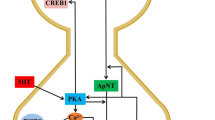Summary
The mechanisms responsible for octopaminecaused increases of excitability of interneuron A of the lateral giant escape reaction circuit of the crayfish, Procambarus clarkii, were investigated.
-
1.
Octopamine increases the amplitude of compound and unitary EPSPs. Neither resting potential, input impedance, nor critical firing level appear to be altered.
-
2.
Increases of unitary EPSP amplitude are accompanied by increases in coefficient of variation as well as by increases in rise and fall times.
-
3.
The above changes suggest that transmission from single afferents to interneuron A occurs at more than one type of synapse or ‘transmission site’. Under control conditions the EPSP is generated largely by sites producing EPSPs having little trial-to-trial variability, while octopamine activates sites having high variability of release. Though the coefficient of variation of EPSP amplitude falls (or remains unchanged) at each type of site individually, the addition of a variable contribution to the relatively non-variable EPSPs of control conditions causes a rise in the coefficient of variation of total amplitude in octopamine. It is also suggested that the less variable sites produce fast EPSPs while the more variable sites produce slow ones.
Similar content being viewed by others
Abbreviations
- int A :
-
interneuron A
References
Bryan JS, Krasne FB (1977) Presynaptic inhibition: the mechanism of protection from habituation of the crayfish lateral giant fibre escape response. J Physiol (Lond) 271:369–390
Dale N, Roberts A (1985) Dual-component amino-acid-mediated synaptic potentials: excitatory drive for swimming in Xenopus embryos. J Physiol (Lond) 363:35–59
Glanzman DL, Krasne FB (1983) Serotonin and octopamine have opposite modulatory effects on the crayfish's lateral giant escape reaction. J Neurosci 3:2263–2269
Hartzell HC (1981) Mechanisms of slow postsynaptic potentials. Nature (Lond) 291:539–544
Kennedy D (1971) Crayfish interneurons. Physiologist 14:5–30
Krasne FB (1969) Excitation and habituation of the crayfish escape reflex: The depolarizing response in lateral giant fibres of the isolated abdomen. J Exp Biol 50:29–46
Krasne FB (1976) Invertebrate systems as a means of gaining insight into the nature of learning and memory. In: Rosenzweig MR, Bennett EL (eds) Neural mechanisms of learning and memory. MIT Press, Cambridge, Massachusetts, pp 401–429
Krasne FB, Glanzman DL (1986) Sensitization of the crayfish lateral giant escape reaction. J Neurosci 6:1013–1020
Krasne FB, Lee SH (1977) Survival of functional synapses on crustacean neurons lacking cell bodies. Brain Res 121:43–57
Krasne FB, Miller MW (1987) Cholinergic transmission at sensory synapses of crayfish lateral giant escape reaction circuit. Soc Neurosci Abstr 13:236
Kuba K, Koketsu K (1976) Analysis of the slow excitatory postsynaptic potential in bullfrog sympathetic ganglion cells. Jpn J Physiol 26:651–669
Mayer ML, Westbrook GL (1987) The physiology of excitatory amino acids in the vertebrate central nervous system. Progr Neurobiol 228:197–276
Miller MW, Lee SC, Krasne FB (1987) Cooperativity-dependent long-lasting potentiation in the crayfish lateral giant escape reaction circuit. J Neurosci 7:1081–1092
Pasztor VM, Bush MH (1987) Peripheral modulation of mechanosensitivity in primary afferent neurons. Nature 326:793–795
van Harreveld A (1936) A physiological solution for freshwater crustaceans. Proc Soc Exp Biol Med 34:428–432
Wiese K (1976) Mechanoreceptors for near-field water displacements in crayfish. J Neurophysiol 39:816–833
Wojtowicz JM, Atwood HL (1986) Long-term facilitation alters transmitter releasing properties at the crayfish neuromuscular junction. J Neurophysiol 55:484–498
Zucker RS (1972) Crayfish escape behavior and central synapses. II. Physiological mechanisms underlying behavioral habituation. J Neurophysiol 35:621–637
Author information
Authors and Affiliations
Rights and permissions
About this article
Cite this article
Bustamante, J., Krasne, F.B. Effects of octopamine on transmission at the first synapse of the crayfish lateral giant escape reaction pathway. J Comp Physiol A 169, 369–377 (1991). https://doi.org/10.1007/BF00207001
Accepted:
Issue Date:
DOI: https://doi.org/10.1007/BF00207001




